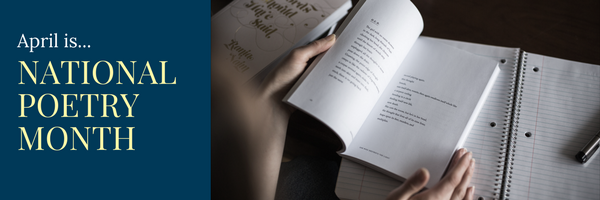
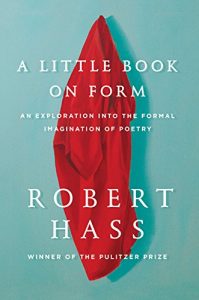 A Little Book on Form: An Exploration into the Formal Imagination of Poetry – Robert Haas
A Little Book on Form: An Exploration into the Formal Imagination of Poetry – Robert Haas
“From the former U.S. Poet Laureate, Pulitzer Prize and National Book Award-winner, an illuminating dissection of poetic form, traditional and modern, for students, enthusiasts, and newcomers alike
In addition to his magisterial poetry, Robert Hass is beloved for his incisive, meditative criticism. A Little Book on Form takes up the central contradiction between poetry as genre and the poetics of the imagination. A wealth of vocabulary exists with which to talk about, map, and explain poetry in rigorous formal terms. But the more intuitive, creative aspects of a poet’s work and processes are more elusive: if the most interesting parts of form are those expressive, essential gestures inside it, how can we come to a better understanding of form as passion, as art?
A Little Book on Form brilliantly synthesizes Hass’s formidable gifts as both a poet and a critic. In suggestive, informal “notes,” Hass breaks the idea of a poem down to its barest building blocks, from the one line haiku to the villanelle and sonnet. His approach singularly employs postmodern perspectives on shape, thought, feeling, content, and movement, calling on Catullus and Allen Ginsberg, Issa and Czeslaw Milosz. Begun as a project for students of poetry, A Little Book is anything but—Hass investigates the ancient roots of the poetic impulse, taking a wide-ranging look at the most intense experience of human thought and feeling in language.”
 Why Poetry – Matthew Zapruder
Why Poetry – Matthew Zapruder
“In Why Poetry, award-winning poet Matthew Zapruder takes on what it is that poetry—and poetry alone—can do. Zapruder argues that the way we have been taught to read poetry is the very thing that prevents us from enjoying it. In lively, lilting prose, he shows us how that misunderstanding interferes with our direct experience of poetry and creates the sense of confusion or inadequacy that many of us feel when faced with it.
Zapruder explores what poems are, and how we can read them, so that we can, as Whitman wrote, “possess the origin of all poems,” without the aid of any teacher or expert. Most important, he asks how reading poetry can help us to lead our lives with greater meaning and purpose.”
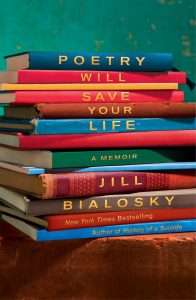 Poetry Will Save Your Life: A Memoir – Jill Bialosky
Poetry Will Save Your Life: A Memoir – Jill Bialosky
“An unconventional and inventive coming-of-age memoir organized around fifty-one remarkable poems by poets such as Robert Frost, Emily Dickinson, Wallace Stevens and Sylvia Plath, from a critically acclaimed New York Times bestselling author and poet.
For Jill Bialosky, certain poems stand out like signposts at pivotal moments in a life: the death of a father, adolescence, first love, leaving home, the suicide of a sister, marriage, the birth of a child, the day in New York City the Twin Towers fell. As Bialosky narrates these moments, she illuminates the ways in which particular poems offered insight, compassion, and connection, and shows how poetry can be a blueprint for living. In Poetry Will Save Your Life, Bialosky recalls when she encountered each formative poem, and how its importance and meaning evolved over time, allowing new insights and perceptions to emerge.
While Bialosky’s personal stories animate each poem, they touch on many universal experiences, from the awkwardness of girlhood, to crises of faith and identity, from braving a new life in a foreign city to enduring the loss of a loved one, from becoming a parent to growing creatively as a poet and artist.
In Poetry Will Save Your Life, Bialosky has crafted an engaging and entirely original examination of a life while celebrating the enduring value of poetry, not as a purely cerebral activity, but as a means of conveying personal experience and as a source of comfort and intimacy. In doing so she brilliantly illustrates the ways in which poetry can be an integral part of life itself and can, in fact, save your life.”
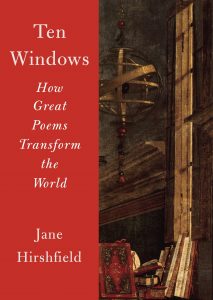 Ten Windows: How Great Poems Transform the World – Jane Hirshfield
Ten Windows: How Great Poems Transform the World – Jane Hirshfield
“”Poetry,” Jane Hirshfield has said, “is language that foments revolutions of being.” In ten eloquent and highly original explorations, she unfolds some of the ways this is done–by the inclusion of hiddenness, paradox, and surprise; by a perennial awareness of the place of uncertainty in our lives; by language’s own acts of discovery; by the powers of image, statement, music, and feeling to enlarge in every direction. Closely reading poems by Dickinson, Bashō, Szymborska, Cavafy, Heaney, Bishop, and Komunyakaa, among others, Hirshfield reveals how poetry’s world-making takes place: word by charged word. By expanding what is imaginable and sayable, Hirshfield proposes, poems expand what is possible. Ten Windows restores us at every turn to a more precise, sensuous, and deepened experience of our shared humanity and of the seemingly limitless means by which that knowledge is both summoned and forged.”
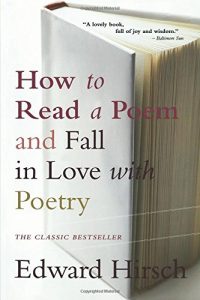 How to Read a Poem and Fall in Love with Poetry – Edward Hirsch
How to Read a Poem and Fall in Love with Poetry – Edward Hirsch
“In language at once acute and emotional, distinguished poet and critic Edward Hirsch describes why poetry matters and how we can open up our imaginations so that its message can make a difference. In a marvelous reading of verse from around the world, including work by Pablo Neruda, Elizabeth Bishop, Wallace Stevens, and Sylvia Plath, among many others, Hirsch discovers the true meaning of their words and ideas and brings their sublime message home into our hearts. A masterful work by a master poet, this brilliant summation of poetry and human nature will speak to all readers who long to place poetry in their lives.”
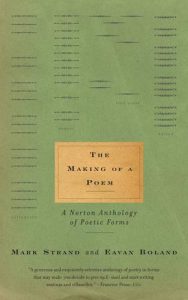 The Making of a Poem: A Norton Anthology of Poetic Forms – Eavan Boland, Mark Strand
The Making of a Poem: A Norton Anthology of Poetic Forms – Eavan Boland, Mark Strand
“Two of our foremost poets provide here a lucid, straightforward primer that “looks squarely at some of the headaches and mysteries of poetic form”: a book for readers who have always felt that an understanding of form (sonnet, ballad, villanelle, sestina, among others) would enhance their appreciation of poetry. Tracing “the exuberant history of forms,” they devote one chapter to each form, offering explanation, close reading, and a rich selection of examplars that amply demonstrate the power and possibility of that form.”
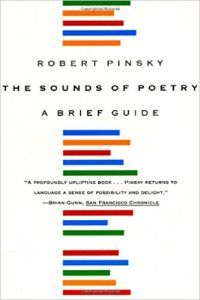 The Sounds of Poetry: A Brief Guide – Robert Pinsky
The Sounds of Poetry: A Brief Guide – Robert Pinsky
“Poetry is a vocal, which is to say a bodily, art,” Robert Pinsky declares in The Sounds of Poetry. “The medium of poetry is the human body: the column of air inside the chest, shaped into signifying sounds in the larynx and the mouth. In this sense, poetry is as physical or bodily an art as dancing.”
As Poet Laureate, Pinsky is one of America’s best spokesmen for poetry. In this fascinating book, he explains how poets use the “technology” of poetry–its sounds–to create works of art that are “performed” in us when we read them aloud.
He devotes brief, informative chapters to accent and duration, syntax and line, like and unlike sounds, blank and free verse. He cites examples from the work of fifty different poets–from Shakespeare, Donne, and Herbert to W. C. Williams, Frost, Elizabeth Bishop, C. K. Williams, Louise Glück, and Frank Bidart.”
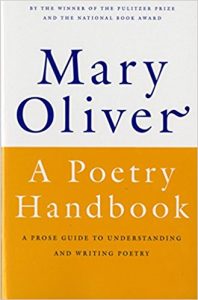 A Poetry Handbook – Mary Oliver
A Poetry Handbook – Mary Oliver
“With passion, wit, and good common sense, the celebrated poet Mary Oliver tells of the basic ways a poem is built-meter and rhyme, form and diction, sound and sense. Drawing on poems from Robert Frost, Elizabeth Bishop, and others, Oliver imparts an extraordinary amount of information in a remarkably short space.”
